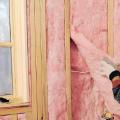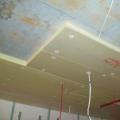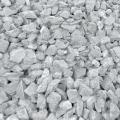DIY expanded clay concrete house
The lifespan of the house depends on the durability of the walls. In addition to strength, the characteristics of enclosing structures (walls) must comply with building standards - frost resistance, heat protection, vapor and air permeability. The walls are required to ensure a certain temperature and humidity regime in the rooms, and for a full year.
Monolithic walls with expanded clay filler, made of concrete prepared directly on the construction site, meet all modern requirements for enclosing structures.
Advantages of expanded clay concrete walls
Expanded clay - a filler for expanded clay concrete - does not contain any other components other than ordinary clay. Expanded clay granules are formed when clay foam is annealed. Their shell is durable; ordinary air is “sealed” inside it - an ideal heat insulator.
Expanded clay granules do not rot, do not react to moisture, do not burn and do not create conditions for the development of fungi and insects. A significant advantage of expanded clay, called “gravel” and “sand” depending on the size of the granules, is its low cost.
Features of choosing expanded clay concrete components
To obtain lightweight concrete with a density not exceeding 800 kg/m3, the working mixture is made up of:
- expanded clay gravel, fraction 4-8 mm;
- expanded clay sand, fraction 0-4 mm;
- cement, grade M400 or M500.
Fine-grained filler (sand) is required in two times less volume than coarse filler (gravel). Please note that you will need expanded clay granules of the 4-8 mm fraction, and not the more common 5-10 mm. Firstly, it is technologically more difficult to work with large grains. Secondly, the surfaces of large expanded clay gravel are characterized by porosity, reaching 20% on the scale of one batch of grain. Thirdly, expanded clay of the 4-8 mm fraction is more spherical in shape than larger fractions. Its granules are better mixed into the mortar, moistened faster and covered with cement laitance, which ensures the required strength of monolithic wall blocks. If you ignore the condition for the size of expanded clay and use 5-10 mm grain, then the cast blocks will not be strong enough - due to the irregular shape of the granules, there will be free space between them, unfilled with cement mortar. Walls made from blocks with too large a filler will not be of sufficient quality.
 Mixing high-quality expanded clay concrete in a concrete mixer requires the use of high-quality cement (ideally M500) - light filler grains have weak contact with each other, and only a “strong” solution can firmly connect them. It is important to maintain the calculated proportions of expanded clay concrete with complete accuracy in order to:
Mixing high-quality expanded clay concrete in a concrete mixer requires the use of high-quality cement (ideally M500) - light filler grains have weak contact with each other, and only a “strong” solution can firmly connect them. It is important to maintain the calculated proportions of expanded clay concrete with complete accuracy in order to:
- obtain a high-quality expanded clay block as part of the wall;
- eliminate excess consumption of concrete components;
- do not degrade the thermal insulation qualities of the wall.
The working mixture must contain a cement binder in an amount sufficient to cover all expanded clay grains with a thin layer of mortar, without filling significant space between the filler. Also, to achieve uniformity and porosity of the expanded clay block, it is necessary that the solution does not drain from the expanded clay granules after laying in the formwork.
Composition of expanded clay concrete
You can set the optimal proportions for expanded clay concrete yourself. The optimal volume of expanded clay for experimentation is a liter jar. By testing a working solution consisting of different amounts of cement and water on this volume of grains, you will be able to derive your own formula for the mixture. The main thing is to ensure that it meets the conditions described above.
The approximate ratio of the components of expanded clay concrete by volume is as follows - 1.5: 1: 1: 0.7 = P: K: C: V, where “P” is expanded clay sand, “K” is expanded clay gravel, “C” is cement and “ B" - water.
 In order to save on binder (cement) and reduce the water content, while simultaneously increasing the mobility of the expanded clay concrete mixture - this will simplify the task of eliminating voids when casting into formwork - it is necessary to introduce a superplasticizer or hyperplasticizer into the concrete solution. Polymer plasticizers of the “super” class make it possible to reduce mixing water by 25%, of the “hyper” class - by 35-40%. You don’t have to calculate the dosage of plasticizers yourself - on the packages of “super” (the popular brand “S-3”) or “hyper” (the popular brand “M5Plus”) the calculated portions are given for the volume of concrete mixture. Reducing the volume of mixing water will increase the strength of expanded clay concrete without increased cement consumption. If you reduce the water-cement ratio from 0.5 to 0.4 thanks to the plasticizer, you will be able to increase the strength of concrete from the original M300 to the actual M550. Let us note that in the modern construction industry, concrete with a strength of more than M250 without the use of super and hyperplasticizers in the mixture is not produced - it is technologically and economically unprofitable.
In order to save on binder (cement) and reduce the water content, while simultaneously increasing the mobility of the expanded clay concrete mixture - this will simplify the task of eliminating voids when casting into formwork - it is necessary to introduce a superplasticizer or hyperplasticizer into the concrete solution. Polymer plasticizers of the “super” class make it possible to reduce mixing water by 25%, of the “hyper” class - by 35-40%. You don’t have to calculate the dosage of plasticizers yourself - on the packages of “super” (the popular brand “S-3”) or “hyper” (the popular brand “M5Plus”) the calculated portions are given for the volume of concrete mixture. Reducing the volume of mixing water will increase the strength of expanded clay concrete without increased cement consumption. If you reduce the water-cement ratio from 0.5 to 0.4 thanks to the plasticizer, you will be able to increase the strength of concrete from the original M300 to the actual M550. Let us note that in the modern construction industry, concrete with a strength of more than M250 without the use of super and hyperplasticizers in the mixture is not produced - it is technologically and economically unprofitable.
If a “factory” plasticizer is not available, its task in the expanded clay concrete mixture can be performed by ordinary shampoo or liquid soap, the cheapest. 50 mm of plasticizer-shampoo is enough to mix a concrete mixer. Such improvised plasticizers will improve the fluidity of the solution and its covering power of expanded clay grains. By the way, during plastering work, which is mandatory upon completion of the construction of monolithic expanded clay concrete walls, it is also worth introducing a plasticizer from shampoo or liquid soap into the solution. As a result, the plaster mixture will not delaminate, which will allow it to be prepared in the required volume, and the higher plasticity of the plaster solution will ensure a better result of the work.
It’s easy to make expanded clay concrete:
- the concrete mixer turns on;
- a portion of water with a plasticizer is poured, then a measured volume of cement;
- after mixing water and cement, expanded clay sand is poured in;
- Expanded clay gravel is poured last.
Mixing the components of expanded clay concrete in a concrete mixer must be done with great care - each grain of expanded clay must be covered with the solution. If necessary, add a little more water while mixing the solution.
How to build walls from monolithic expanded clay concrete
 First of all, formwork is needed to cast the concrete block. Ready-made formwork systems offered for rent by construction companies for private road construction. It is more profitable to buy adjustable formwork (small) or make it yourself - from plywood sheets, ties (metal studs with nuts) and boards.
First of all, formwork is needed to cast the concrete block. Ready-made formwork systems offered for rent by construction companies for private road construction. It is more profitable to buy adjustable formwork (small) or make it yourself - from plywood sheets, ties (metal studs with nuts) and boards.
The internal width of the formwork block is determined by the required thickness of the walls of the house. For a country cottage designed for summer living, 350 mm of wall is enough. And for a major energy-efficient building - minimal heat loss through the enclosing structures - a wall with a thickness of at least 500 mm is needed.
Casting expanded clay concrete walls is carried out almost by analogy with other monolithic structures:
- we set up the formwork;
- we thread the fastening pins into sections of plastic tube or cable duct and fix the formwork;
- we cast expanded clay concrete into the formwork block and tamp it lightly;
- we wait for the setting period, dismantle and move the panels to a new location;
- then the processes listed above are repeated until the construction of monolithic walls.
If the dimensions of the adjustable formwork are small, it is easier to start casting the walls from the corners or edges of the opening. Although, with sufficient dimensions, formwork boxes can be placed along the entire perimeter of the building or half of it, starting installation from the doorway. Expanded clay concrete is lightweight - the load on the formwork structure will be small. Before loading the mortar mixture, the “bottom” of the formwork block placed on the foundation should be moistened with water and sprinkled with cement or, better yet, cement-based glue. This “iron” will help glue the cast block to the base of the wall.
 When creating the next wall section, first fill the formwork with expanded clay concrete not completely - to about 200 mm in height. The laid first layer must be compacted using a special tamper - a light (no more than 1 kg in weight) log with side handles. When applying gentle blows - so as not to break the expanded clay granules - try to squeeze out the air from the mixture, which will ensure reliable adhesion of the filler and provide the necessary thermal insulation characteristics of the wall. Further laying of expanded clay concrete mortar is also carried out layer by layer, with tamping. After loading the mixture into the formwork to the top (without a slide), cover it with plastic wrap. This measure will protect the expanded clay block from being washed out in case of rain and will create a humid atmosphere inside the formwork, promoting strong cement adhesion with uniform access of moisture.
When creating the next wall section, first fill the formwork with expanded clay concrete not completely - to about 200 mm in height. The laid first layer must be compacted using a special tamper - a light (no more than 1 kg in weight) log with side handles. When applying gentle blows - so as not to break the expanded clay granules - try to squeeze out the air from the mixture, which will ensure reliable adhesion of the filler and provide the necessary thermal insulation characteristics of the wall. Further laying of expanded clay concrete mortar is also carried out layer by layer, with tamping. After loading the mixture into the formwork to the top (without a slide), cover it with plastic wrap. This measure will protect the expanded clay block from being washed out in case of rain and will create a humid atmosphere inside the formwork, promoting strong cement adhesion with uniform access of moisture.
In the closed position, the concreting block remains for a day or two. If the air temperature is below +18 o C, the expanded clay block takes twice as long to set. This scheme for constructing walls is convenient for independent house construction, especially when visiting a construction site “on weekends.” The technology of monolithic construction of expanded clay blocks allows you to gradually build walls in a volume no less than daily bricklaying. In one day, if there is a sufficient number of formwork elements, several cubic meters of wall can be erected.
The formwork is removed from the finished block - the nuts on the ties are screwed together, the studs are removed, the box is disassembled - and reassembled on the next section of the wall. It is important not to forget about installing new sections of PVC pipe and cable duct on the tie rods, otherwise they will be concreted into the block. In the future, the holes in the blocks left from the screeds will be useful for anchoring the formwork in the new sector, which will make it easier to maintain the verticality and straightness of the wall. 
The construction of the second row of blocks must begin as soon as it becomes possible to install formwork boxes on the second row. It is most convenient to install expanded clay concrete walls with ledges - it will be possible to put into operation the largest number of formwork sets. The second and subsequent rows are made on top of the lower row of cast expanded clay blocks without special application of the solution - you just need to moisten the ends of the lower blocks with water.
If you find that the expanded clay grains adhere weakly to the surface of the dried blocks and lag behind, do not worry - this is normal. Sweep dry blocks with a hard broom and remove weak expanded clay granules - they will interfere with subsequent plastering work.
In conclusion
Pay attention! Lintels cast over door and window openings must be made from expanded clay concrete of higher strength or, more correctly, from ordinary concrete!
When casting expanded clay concrete blocks, you can arrange in them technological grooves for floor beams, holes for hidden wiring, etc. To make them, before pouring the concrete mixture, you need to install liners of the required size in the formwork box - after stripping, they need to be removed.
According to the technology of monolithic construction of an expanded clay concrete wall, it is necessary to perform its horizontal reinforcement. For this, 10-16 mm reinforcement is used, set in increments of 100-150 mm, or welded mesh.
 Construction materials and list of works
Construction materials and list of works Proper insulation of a wooden ceiling in a private house
Proper insulation of a wooden ceiling in a private house What types of crushed stone are there?
What types of crushed stone are there?